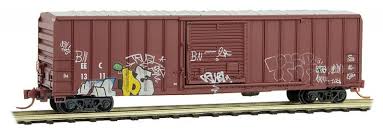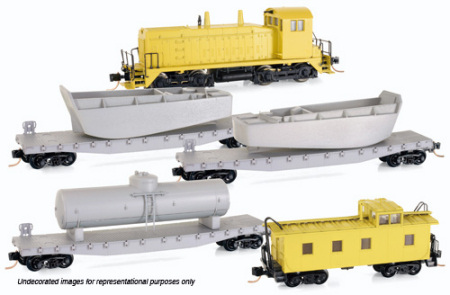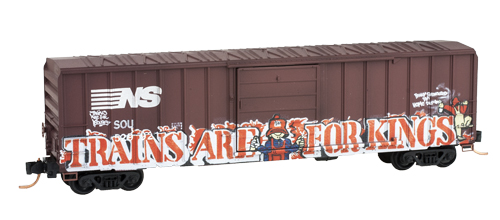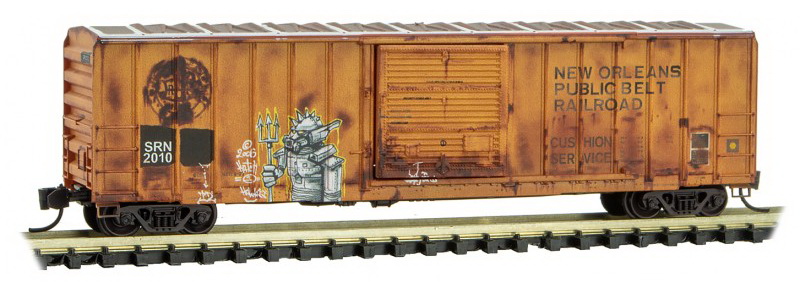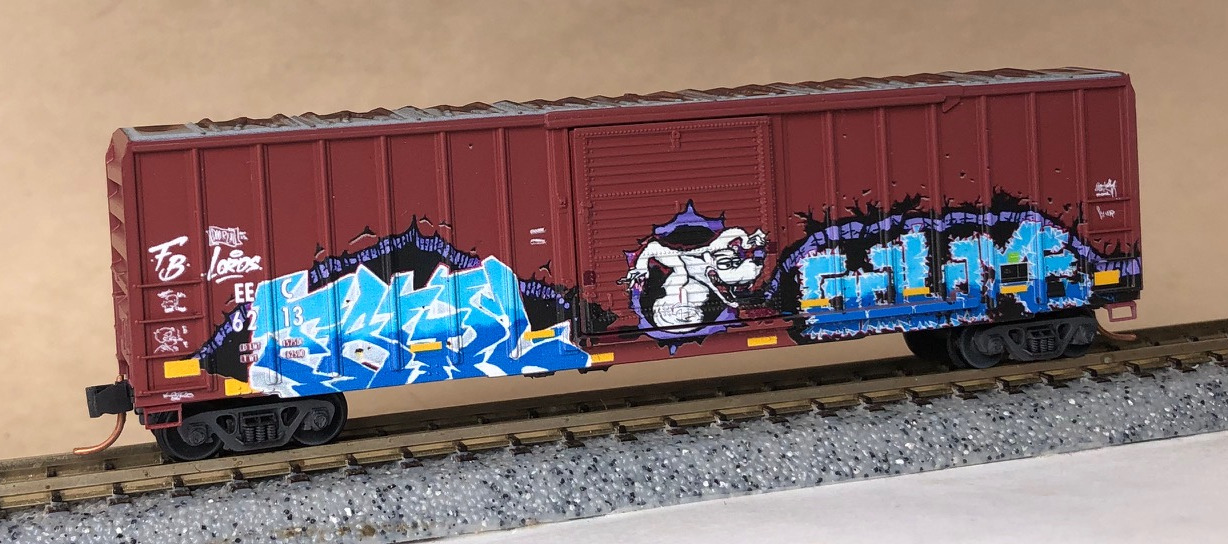Model Information: This model was first produced by Kadee in February of 1981. It is a model of a 50 Foot Steel Rib-Side Single Sliding Door Boxcar. Specifically, this Micro-Trains body style models the FMC 50' 5077 Single Sliding Door prototype. It is also used by Micro-Trains to model Pullman Standard 50' boxcars. Hence on some releases, this car is labeled as a Pullman Standard and in other cases it is labeled as an FMC boxcar, and it also is frequently labeled as a '50' Rib Side Box Car[sic]' with no mention of prototype whatsoever. It appears to be closest to the FMC 5077 boxcar prototype (from the 1970s) in any event. These models can appear with any one of multiple different sliding door types. The doors for this model are operating ones (cool!).
Prototype History: In the 1970's with the growth of the Per Diem business model, FMC produced a series of 50 foot box cars in different configurations. The single-sliding-door configuration is one of the best known and used widely by many different railroads. These cars were produced using the Gunderson metal works which FMC had acquired in 1965. In late 1975, FMC began producing a 5,077-cubic-foot Plate B box car for IPD and Railbox service. FMC's 5077s have seven panels to either side of the 10-foot door, an X-panel roof, and non-terminating ends that are slightly different from those used on FMC's earlier cars. Note how the sidesill is notched all the way back to the bolsters, a key feature of FMC's mature design.
The main difference between the 5077 cu. ft cars built by FMC vs the 5277-5347 cu. ft cars built by the same manufacturers is the overall height of the car, the smaller 5077 cars were Plate B while the larger 5277-5347 cars were Plate C. Over 4,300 cars were produced from 1975-1979 by FMC's Portland, Oregon plant. The cars were delivered in numerous colorful shortline paint schemes, as well as the nationwide car pool fleet of Railbox. Many secondhand cars were later seen in Class 1 railroads and large leasing company fleets under additional shortline reporting marks.
The main difference between the 5077 cu. ft cars built by FMC vs the 5277-5347 cu. ft cars built by the same manufacturers is the overall height of the car, the smaller 5077 cars were Plate B while the larger 5277-5347 cars were Plate C. Over 4,300 cars were produced from 1975-1979 by FMC's Portland, Oregon plant. The cars were delivered in numerous colorful shortline paint schemes, as well as the nationwide car pool fleet of Railbox. Many secondhand cars were later seen in Class 1 railroads and large leasing company fleets under additional shortline reporting marks.
Road Name History: 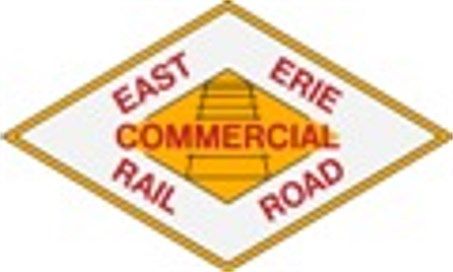 The East Erie Commercial Railroad is a single-track, standard-gage, electrically operated railway, located within the State of Pennsylvania. The main line extends northeasterly from Erie to near Harborcreek, including a line entirely around the plant of the General Electric Company. The main line mileage aggregates 6.726 miles. The carrier also owns and uses 3.632 miles of yard tracks and sidings, making a total of 10.358 miles of all tracks. The carrier grants trackage rights to the General Electric Company over a portion of its railroad.
The East Erie Commercial Railroad is a single-track, standard-gage, electrically operated railway, located within the State of Pennsylvania. The main line extends northeasterly from Erie to near Harborcreek, including a line entirely around the plant of the General Electric Company. The main line mileage aggregates 6.726 miles. The carrier also owns and uses 3.632 miles of yard tracks and sidings, making a total of 10.358 miles of all tracks. The carrier grants trackage rights to the General Electric Company over a portion of its railroad.
The EEC was incorporated October 17, 1907, under general laws of Pennsylvania, for the purpose of constructing, maintaining, and operating a railroad for public use, principally to serve the General Electric Company. The date of organization was October 19, 1907. A supplemental charter dated January 25, 1910, was granted under the same general laws of Pennsylvania.
That portion of the main line of the EEC known as the "Loop" was constructed for it by the General Electric Company in connection with the building of its plant. Work was begun on October 22, 1907, but the records do not indicate date of completion. Commercial operation was begun in 1911. Construction of the Eastern Division, extending from Franklin Road to Harborcreek Township, about 4 miles, was begun about July 1, 1915. Contracts were made with the General Electric Company for the electric work at cost plus overhead and for the excavation and grading on force account basis, the balance of the work being done by carrier's own forces.

The EEC was incorporated October 17, 1907, under general laws of Pennsylvania, for the purpose of constructing, maintaining, and operating a railroad for public use, principally to serve the General Electric Company. The date of organization was October 19, 1907. A supplemental charter dated January 25, 1910, was granted under the same general laws of Pennsylvania.
That portion of the main line of the EEC known as the "Loop" was constructed for it by the General Electric Company in connection with the building of its plant. Work was begun on October 22, 1907, but the records do not indicate date of completion. Commercial operation was begun in 1911. Construction of the Eastern Division, extending from Franklin Road to Harborcreek Township, about 4 miles, was begun about July 1, 1915. Contracts were made with the General Electric Company for the electric work at cost plus overhead and for the excavation and grading on force account basis, the balance of the work being done by carrier's own forces.
Brand/Importer Information: Micro-Trains is the brand name used by both Kadee Quality Products and Micro-Trains Line. For a history of the relationship between the brand and the two companies, please consult our Micro-Trains Collector's Guide.
Manufacturer Information:  Micro-Trains Line split off from Kadee Quality Products in 1990. Kadee Quality Products originally got involved in N-Scale by producing a scaled-down version of their successful HO Magne-Matic knuckle coupler system. This coupler was superior to the ubiquitous 'Rapido' style coupler due to two primary factors: superior realistic appearance and the ability to automatically uncouple when stopped over a magnet embedded in a section of track. The success of these couplers in N-Scale quickly translated to the production of trucks, wheels and in 1972 a release of ready-to-run box cars.
Micro-Trains Line split off from Kadee Quality Products in 1990. Kadee Quality Products originally got involved in N-Scale by producing a scaled-down version of their successful HO Magne-Matic knuckle coupler system. This coupler was superior to the ubiquitous 'Rapido' style coupler due to two primary factors: superior realistic appearance and the ability to automatically uncouple when stopped over a magnet embedded in a section of track. The success of these couplers in N-Scale quickly translated to the production of trucks, wheels and in 1972 a release of ready-to-run box cars.
Micro-Trains Line Co. split off from Kadee in 1990 to form a completely independent company. For this reason, products from this company can appear with labels from both enterprises. Due to the nature of production idiosyncrasies and various random factors, the rolling stock from Micro-Trains can have all sorts of interesting variations in both their packaging as well as the products themselves. When acquiring an MTL product it is very important to understand these important production variations that can greatly enhance (or decrease) the value of your purchase.
Please consult our Micro-Trains Collector's Guide

Micro-Trains Line Co. split off from Kadee in 1990 to form a completely independent company. For this reason, products from this company can appear with labels from both enterprises. Due to the nature of production idiosyncrasies and various random factors, the rolling stock from Micro-Trains can have all sorts of interesting variations in both their packaging as well as the products themselves. When acquiring an MTL product it is very important to understand these important production variations that can greatly enhance (or decrease) the value of your purchase.
Please consult our Micro-Trains Collector's Guide
Item created by: gdm on 2016-12-15 10:07:52. Last edited by CNW400 on 2020-05-11 16:53:27
If you see errors or missing data in this entry, please feel free to log in and edit it. Anyone with a Gmail account can log in instantly.
If you see errors or missing data in this entry, please feel free to log in and edit it. Anyone with a Gmail account can log in instantly.


